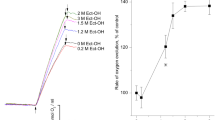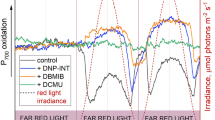Abstract
In our search for new natural photosynthetic inhibitors that could lead to the development of “green herbicides” less toxic to environment, the diterpene labdane-8α,15-diol (1) and its acetyl derivative (2) were isolated for the first time from Croton ciliatoglanduliferus Ort. They inhibited photophosphorylation, electron transport (basal, phosphorylating and uncoupled) and the partial reactions of both photosystems in spinach thylakoids. Compound 1 inhibits the photosystem II (PS II) partial reaction from water to Na+ Silicomolibdate (SiMo) and has no effect on partial reaction from diphenylcarbazide (DPC) to 2,6-dichlorophenol indophenol (DCPIP), therefore 1 inhibits at the water splitting enzyme and also inhibits PS I partial reaction from reduced phenylmetasulfate (PMS) to methylviologen (MV). Thus, it also inhibits in the span of P700 to Iron sulfur center X (FX). Compound 2 inhibits both, the PS II partial reactions from water to SiMo and from DPC to DCPIP; besides this, it inhibits the photosystem I (PS I) partial reaction from reduced PMS to MV. With these results, we concluded that the targets of the natural product 2 are located at the water splitting enzyme, and at P680 in PS II and at the span of P700 to FX in PS I. The results of compounds 1 and 2 on PS II were corroborated by chlorophyll a fluorescence.







Similar content being viewed by others
Abbreviations
- ADP:
-
Adenosine diphosphate
- ATP:
-
Adenosine triphosphate
- Chl:
-
Chlorophyll
- DBMIB:
-
2,5-Dibromo-6-isopropyl-3-methyl-1,4-benzoquinone
- DCPIP:
-
2,6-Dichlorophenol indophenol
- DPC:
-
Diphenylcarbazide
- D1 :
-
Subunit D1 of PS II
- EPR:
-
Electron paramagnetic resonance
- F 0 :
-
Fluorescence level when plastoquinone electron acceptor pool (Q a) is fully oxidized
- F 300 :
-
Fluorescence intensity at 300 μs
- F J :
-
Fluorescence intensity at the J-step (at 2 ms)
- F m :
-
Fluorescence level when Q a is transiently fully reduced
- F v :
-
Variable fluorescence (F m−F 0)
- Fv/Fm:
-
Maximum quantum efficiency of photosystem II
- F x :
-
Iron sulfur center
- M 0 :
-
4(F 300−F 0)/(F m−F 0)
- MV:
-
Methylviologen
- OEC:
-
Oxygen evolving complex
- PEA:
-
Plant efficiency analyzer
- PMS:
-
Phenylmetasulfate
- PS I:
-
Photosystem I
- PS II:
-
Photosystem II
- QA (QB):
-
Primary (secondary) quinone electron acceptor of PS II
- P700 :
-
PS I reaction center
- SiMo:
-
Sodium silicomolybdate
- VCC:
-
Via column chromatography
References
Allen JF, Holmes NG (1986) Electron transport partial reactions. In: Hipkinns MF, Baker NR (eds) Photosynthesis, energy transduction. A practical approach, Chap. 5. IRL Press, Oxford United Kingdom, pp 103–141
Armstrong JMcD (1964) The molar extinction coefficient of 2,6-dichlorophenol indophenol. Biochim Biophys Acta 86:194–197
Carman RM (1973) The optical rotation of tertiary alcohols. Aust J Chem 26:879–881
Castañeda P, Mata R, Lotina B (1998) Effect of encecalin, euparin and demethylencecalin on thylakoid electron transport and photophosphorylation in isolated spinach chloroplasts. J Sci Food Agric 78:102–108
Chávez D, Mata R, Iglesias-Prieto R et al (2001) Annonaceous acetogenins: naturally occurring inhibitors of ATP synthesis and photosystem II in spinach chloroplasts. Physiol Plant 111:262–268
Chinou I (2005) Labdanes of natural origin-biological activities (1981–2004). Curr Med Chem 12:1295–1317
Dilley RA (1972) Ion transport (H+, K+, Mg2+ exchange phenomena). Methods Enzymol 24:68–74
Duke SO, Brian E, Scheffler, Dayan FE (2002) Allelochemicals as herbicides. In: Reigosa M, Pedrol N (eds) Allelopathy from molecules to ecosystems. Science publishing, Inc. NH, USA, pp 183–195
Giaquinta RT, Dilley RA (1975) A partial reaction in photosystem II: reduction of silicomolybdate prior to the site of dichlorophenyldimethyl-urea inhibition. Biochim Biophys Acta 387:288–305
Giaquinta RT, Selman BR, Anderson BJ et al (1974) Inhibition of coupling factor activity of chloroplasts membrane by diazonium compounds. J Biol Chem 249:2873–2878
González AG, Francisco CG, Freire R et al (1976) C12 stereochemistry of α-and β-levantenolide. Carbon-13 NMR spectra of labdanolic diterpenes. Tetrahedron Lett 22:1897–1898
González-Bernardo E, Aguilar MI, Delgado G et al (2003) Photosynthetic electron transport interaction of xanthorrhizol isolated from Iostephane heterophylla and its derivatives. Physiol Plant 119:598–604
González-Vázquez R, King Díaz B, Aguilar MI et al (2006) Pachypodol from Croton ciliatoglanduliferus Ort. as water-splitting enzyme inhibitor on thylakoids. J Agric Food Chem 54:1217–1221
Good NE, Izawa S, Hind G (1981) Uncoupling and energy transfer inhibition in Photophosphorylation. In: Sanadi DR (ed) Current topics in bioenergetics, vol 1 Academic Press, New York, pp 75–112
Henrick CA, Jefferies PR (1965) The chemistry of the Euphorbiaceae-XI. The diterpenes of Ricinocarpus muricatus and the stereochemistry of euperuic acid. Tetrahedron 21:1175–1190
Hirota H, Nakamora T, Tsuyuki T et al (1988) Stereoselective total synthesis of (±)-labdane-8α,15-diol and (±)-eperuane-8β,15-diol. Bull Chem Soc Jpn 61:4023–4028
Huerta A, Lopez-Olguin JF, Aragon A et al (2002) Effect of a powder and watery extract of Croton ciliatoglanduliferus Ort. (Euphorbiaceae) incorporated into the diet of Spodoptera littoralis (Boisduval) (Lepidoptera: Noctuidae). Bol Sanid Vegetal Plagas 28:405–414
Izawa S, Krayenhof R, Ruuge EK, DeVault D (1973) The site of KCN inhibition in the photosynthetic electron transport pathway. Biochem Biophys Acta 314:328–339
Izawa S, Hind G (1967) The kinetics of the pH rise in illuminated chloroplast suspensions. Biochem Biophys Acta 143:377–390
King-Díaz B, Piló-Veloso D, Lotina-Hennsen B et al (2006) A diterpene γ-lactone derivate from Pterodon polygalaeflorus as a photosystem II inhibitor and uncoupler of photosynthesis. Z Naturforsch C, J Biosci 61c: 227–233
Lotina-Hennsen B, King-Díaz B, Aguilar MI, et al (2006) Plant secondary metabolites. Targets and mechanisms of allelopathy. In: Reigosa MJ, Pedrol N, González L (eds) Allelopathy: A Physiological Process with Ecological Implications. Kluwer Academic Publishers. Netherlands, pp 229–265
Mills JD, Mitchell P, Shurmann P (1980) Modulation of coupling ATPase activity in intact chloroplasts. FEBS Lett 112:73–177
Mitchel P (1961) Coupling of photophosphorylation to electron and hydrogen transfer by a Chemiosmotic type mechanism. Nature 191:144–148
Ouitrakul R, Izawa S (1973) Electron transport and photophosphorylation in chloroplast a function of electron-acceptor 2. Acceptor-specific inhibition by KCN. Biochim Biophys Acta 305:105–118
Perry NB, Weavers RT (1985) Foliage diterpenes of Dacrydium Intermedium: identification, variation and biosynthesis. Phytochemistry 24: 2899–2904
Rickert KW, Sears J, Beck WF et al (1991) Mechanism of irreversible inhibition of O2 evolution in photosystem II by Tris (hydroxymethyl)aminomethane. Biochemistry 30:7888–7894
Rios MY, Aguilar-Guadarrama AB (2006) Nitrogen-containing phorbol esters from Croton ciliatoglandulifer and their effects on cyclooxygenases-1 and -2. J Nat Prod 69:887–890
Saha S, Ouitrakul R, Izawa S et al (1971) Electron transport and phosphorylation in chloroplasts as a function of the electron acceptor. J Biol Chem 246:3204–3209
Schwartz M (1968) Light induced proton gradient links electron transport and phosphorylation. Nature 219:915–919
Strain HH, Cope T, Svec MA (1971) Analytical procedures for the isolation, identification, estimation and investigation of the chlorophylls. Methods Enzymol 23:452–466
Strasser RJ, Srivastava A, Govindjee (1995) Polyphasic chlorophyll a fluorescence transient in plants and cianobacteria. Photochem Photobiol 66:32–45
Strasser BJ (1997) Donor side capacity of photosystem probed by chlorophyll a fluorescence transients. Photosynth Res 52:147–155
Strasser RJ, Srivastava A, Tsimilli-Michael M (1998) The fluorescence transient as a tool to characterize and screen photosynthetic samples. In: Mohany P, Yunus M, Pathre U (eds) Probing photosynthesis: mechanism, regulation & adaptation. Taylor & Francis, London, pp 42–46
Strasser RJ, Tsimilli-Michael M, Srivastava A (2004) Analysis of the chlorophyll a fluorescence transient. In: Papageorgiou G, Govindjee (eds) Advances in photosynthesis and respiration. chlorophyll fluorescence a signature of photosynthesis, vol 19. Kluwer Academic Publishers, The Netherlands, pp 321–362
Trebst A (1972) Measurement of Hill Reactions and photoreduction. Methods Enzymol 24:146–153
Trebst A (1980) Inhibitors in electron flow: tools for the functional and structural localization of carriers and energy conservation sites. Methods Enzymol 69:675–715
Vernon LP, Shaw ER (1969) Photoreduction of 2,6-dichlorophenol by diphenylcarbazide: a photosystem 2 reaction catalyzed by Tris-washed chloroplasts and subchloroplasts fragments. Plant Physiol 44:1645–1649
Yamashita T Horio T (1968) Non-cyclic photophosphorylation by spinach grana treated with 0.8 M tris buffer. Plant Cell Physiol 9:268–284
Zhou YH, Yu JQ (2006) Allelochemicals and photosynthesis. In: Reigosa JM, Pedrol N, González L (eds) Allelopathy: a physiological process with ecological implications. Springer, Netherlands, pp 127–139
Acknowledgements
The authors thank the financial support of the DGAPA-UNAM IN205806 research project. This research was taken in part from the B.Sc. thesis of F. M. F. We also thank to Professor Nelly Diego for the collection and identification of the plant material used in this work and to M en C Yolanda González, M en C Rosa Isela del Villar, M en C Víctor Manuel Arroyo, M en C Georgina Duarte, QFB Marisela Gutiérrez (Facultad de Química, UNAM) for recording the NMR, MS and IR spectra.
Author information
Authors and Affiliations
Corresponding author
Rights and permissions
About this article
Cite this article
Morales-Flores, F., Aguilar, M.I., King-Díaz, B. et al. Natural diterpenes from Croton ciliatoglanduliferus as photosystem II and photosystem I inhibitors in spinach chloroplasts. Photosynth Res 91, 71–80 (2007). https://doi.org/10.1007/s11120-007-9143-7
Received:
Accepted:
Published:
Issue Date:
DOI: https://doi.org/10.1007/s11120-007-9143-7




